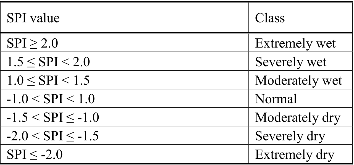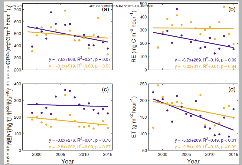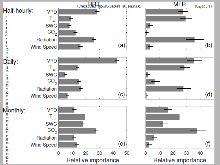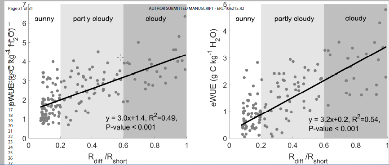|
Seasonal Climate Variability and Change in the Pacific Northwest of the United States
|
journal
|
March 2014 |
|
A multi-species synthesis of physiological mechanisms in drought-induced tree mortality
|
journal
|
August 2017 |
|
Loss of whole-tree hydraulic conductance during severe drought and multi-year forest die-off
|
journal
|
January 2014 |
|
Consequences of widespread tree mortality triggered by drought and temperature stress
|
journal
|
September 2012 |
|
Long tree-ring chronologies reveal 20th century increases in water-use efficiency but no enhancement of tree growth at five Iberian pine forests: IBERIAN PINE PHYSIOLOGICAL AND GROWTH CHANGES
|
journal
|
February 2011 |
|
Respiration as a percentage of daily photosynthesis in whole plants is homeostatic at moderate, but not high, growth temperatures
|
journal
|
April 2007 |
|
Measuring and modelling carbon dioxide and water vapour exchange over a temperate broad-leaved forest during the 1995 summer drought
|
journal
|
September 1997 |
|
Canopy Photosynthesis and Water-Use Efficiency in a Deciduous Forest
|
journal
|
April 1987 |
|
Elevated CO 2 increases tree-level intrinsic water use efficiency: insights from carbon and oxygen isotope analyses in tree rings across three forest FACE sites
|
journal
|
December 2012 |
|
Temporal and among-site variability of inherent water use efficiency at the ecosystem level: VARIABILITY OF INHERENT WUE
|
journal
|
June 2009 |
|
Tree-ring δ 13 C tracks flux tower ecosystem productivity estimates in a NE temperate forest
|
journal
|
July 2014 |
|
Variations in the influence of diffuse light on gross primary productivity in temperate ecosystems
|
journal
|
February 2015 |
|
Snow disappearance timing is dominated by forest effects on snow accumulation in warm winter climates of the Pacific Northwest, United States
|
journal
|
April 2017 |
|
Maximum height in a conifer is associated with conflicting requirements for xylem design
|
journal
|
August 2008 |
|
Native root xylem embolism and stomatal closure in stands of Douglas-fir and ponderosa pine: mitigation by hydraulic redistribution
|
journal
|
July 2004 |
|
Drought timing and local climate determine the sensitivity of eastern temperate forests to drought
|
journal
|
March 2018 |
|
A working guide to boosted regression trees
|
journal
|
July 2008 |
|
Flux partitioning in an old-growth forest: seasonal and interannual dynamics
|
journal
|
April 2008 |
|
Evaporation components of a boreal forest: variations during the growing season
|
journal
|
October 1997 |
|
Evapotranspiration and water use efficiency in relation to climate and canopy nitrogen in U.S. forests: ET AND WUE SCALED WITH CANOPY NITROGEN
|
journal
|
October 2016 |
|
Uncertainty in the response of terrestrial carbon sink to environmental drivers undermines carbon-climate feedback predictions
|
journal
|
July 2017 |
|
Linking tree physiological constraints with predictions of carbon and water fluxes at an old‐growth coniferous forest
|
journal
|
April 2019 |
|
Increase in forest water-use efficiency as atmospheric carbon dioxide concentrations rise
|
journal
|
July 2013 |
|
The response of ecosystem water‐use efficiency to rising atmospheric CO 2 concentrations: sensitivity and large‐scale biogeochemical implications
|
journal
|
November 2016 |
|
Effects of diffuse radiation on canopy gas exchange processes in a forest ecosystem: DIFFUSE RADIATION EFFECTS IN FOREST
|
journal
|
May 2008 |
|
Environmental controls over carbon dioxide and water vapor exchange of terrestrial vegetation
|
journal
|
December 2002 |
|
Carbon implications of current and future effects of drought, fire and management on Pacific Northwest forests
|
journal
|
November 2015 |
|
Linking plant functional trait plasticity and the large increase in forest water use efficiency: WUE Increase Revisited
|
journal
|
September 2017 |
|
Variability in water use efficiency at the leaf level among Mediterranean plants with different growth forms
|
journal
|
October 2008 |
|
Species-specific partitioning of soil water resources in an old-growth Douglas-fir-western hemlock forest
|
journal
|
June 2007 |
|
Comparison of seasonal variations in water-use efficiency calculated from the carbon isotope composition of tree rings and flux data in a temperate forest: Intra-ring δ13C and water-use efficiency
|
journal
|
November 2010 |
|
Tree species effects on ecosystem water-use efficiency in a high-elevation, subalpine forest
|
journal
|
September 2009 |
|
Climate-Driven Variability and Trends in Mountain Snowpack in Western North America
|
journal
|
December 2006 |
|
Future climate in the Pacific Northwest
|
journal
|
May 2010 |
|
Differential tree mortality in response to severe drought: evidence for long-term vegetation shifts
|
journal
|
July 2005 |
|
Machine Learning Methods Without Tears: A Primer for Ecologists
|
journal
|
June 2008 |
|
Three-dimensional Structure of an Old-growth Pseudotsuga-Tsuga Canopy and Its Implications for Radiation Balance, Microclimate, and Gas Exchange
|
journal
|
May 2004 |
|
Twentieth century changes of tree-ring δ 13 C at the southern range-edge of Fagus sylvatica: increasing water-use efficiency does not avoid the growth decline induced by warming at low altitudes
|
journal
|
May 2008 |
|
Large Uptake of Atmospheric OCS Observed at a Moist Old Growth Forest: Controls and Implications for Carbon Cycle Applications
|
journal
|
November 2018 |
|
Ecosystem fluxes of carbonyl sulfide in an old-growth forest: temporal dynamics and responses to diffuse radiation and heat waves
|
journal
|
January 2018 |
|
Tree-Ring Carbon Isotope Records from the Western Oregon Cascade Mountains Primarily Record Summer Maximum Temperatures
|
journal
|
July 2018 |
|
Reduction of ecosystem productivity and respiration during the European summer 2003 climate anomaly: a joint flux tower, remote sensing and modelling analysis
|
journal
|
March 2007 |
|
Severe drought effects on ecosystem CO2 and H2O fluxes at three Mediterranean evergreen sites: revision of current hypotheses?
|
journal
|
October 2002 |
|
Comparing integrated stable isotope and eddy covariance estimates of water-use efficiency on a Mediterranean successional sequence
|
journal
|
August 2014 |
|
Carbon isotopes and water use efficiency: sense and sensitivity
|
journal
|
January 2008 |
|
Ecological Setting of the Wind River Old-growth Forest
|
journal
|
May 2004 |
|
Changes toward Earlier Streamflow Timing across Western North America
|
journal
|
April 2005 |
|
Modelling surface conductance of pine forest
|
journal
|
June 1988 |
|
Leaf area index of an old-growth Douglas-fir forest estimated from direct structural measurements in the canopy
|
journal
|
December 2000 |
|
In situ estimation of net CO2 assimilation, photosynthetic electron flow and photorespiration in Turkey oak (Q. cerris L.) leaves: diurnal cycles under different levels of water supply
|
journal
|
June 1995 |
|
A dynamic leaf gas-exchange strategy is conserved in woody plants under changing ambient CO 2 : evidence from carbon isotope discrimination in paleo and CO 2 enrichment studies
|
journal
|
January 2016 |
|
Differential responses of carbon and water vapor fluxes to climate among evergreen needleleaf forests in the USA
|
journal
|
May 2016 |
|
Forest‐Type‐Dependent Water Use Efficiency Trends Across the Northern Hemisphere
|
journal
|
August 2018 |
|
Vertical stratification of soil water storage and release dynamics in Pacific Northwest coniferous forests
|
journal
|
May 2005 |
|
AmeriFlux US-Wrc Wind River Crane Site
|
dataset
|
January 2016 |
|
Climate indices strongly influence old-growth forest carbon exchange
|
journal
|
April 2016 |
|
Old-growth CO2 flux measurements reveal high sensitivity to climate anomalies across seasonal, annual and decadal time scales
|
journal
|
August 2012 |
|
Regulation of stomatal conductance and transpiration in forest canopies
|
journal
|
August 1998 |
|
Sun-induced fluorescence and gross primary productivity during a heat wave
|
journal
|
September 2018 |
|
Impacts of tree height on leaf hydraulic architecture and stomatal control in Douglas-fir
|
journal
|
May 2007 |
|
Hydrologic implications of vegetation response to elevated CO2 in climate projections
|
journal
|
December 2018 |
|
Remote estimation of terrestrial evapotranspiration without using meteorological data: REMOTE SENSING ET WITHOUT WEATHER INPUTS
|
journal
|
June 2013 |
|
Evaluating the effects of future climate change and elevated CO2 on the water use efficiency in terrestrial ecosystems of China
|
journal
|
July 2011 |







